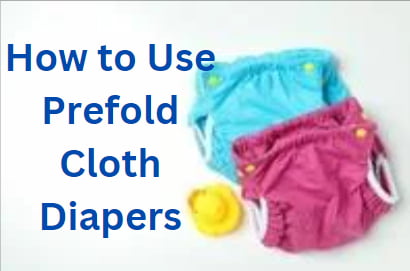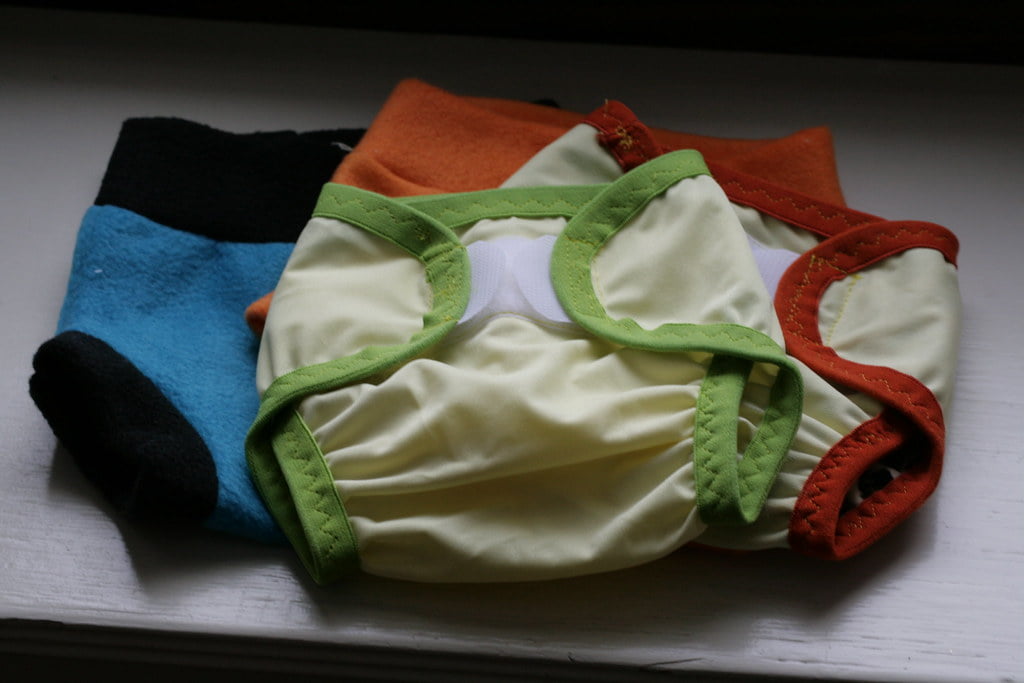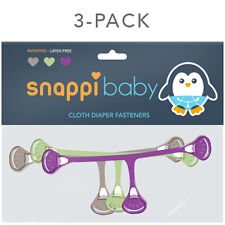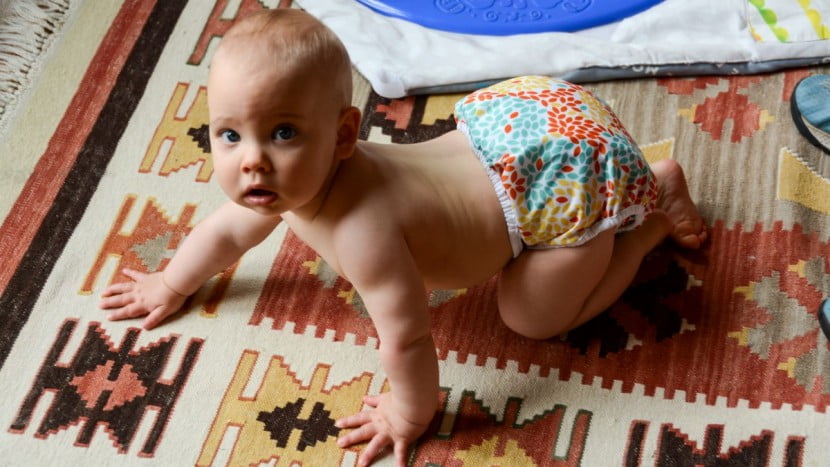How to use prefold cloth diapers? Cloth diapering has experienced an impressive surge in popularity in an ever-more eco-conscious world, particularly prefold cloth diapers which offer simplicity, cost-effectiveness, and environmental friendliness. If you are new to cloth diapering or interested in the subject matter of prefolds this guide provides essential knowledge of prefold usage so you can master their use!
Prefold cloth diapers provide an economical and eco-friendly alternative to disposable diapers, but their initial complexity may seem intimidating. Not to worry; this comprehensive guide will walk you step by step through the process so that you’re confident using prefolds effectively.

No matter your experience level or preference for diapering options, cloth diapering will provide everything you need to know to transition successfully – from choosing prefold cloth diapers and mastering their folding and securing techniques to contributing towards a more sustainable future with each diaper change. With our guide’s help, you will gain the tools to keep your child comfortable and dry while contributing towards a greener future!
Join us as we delve into the world of prefold cloth diapers and unlock their secrets for making them a suitable, eco-friendly option for both you and your baby.
What are Prefold Cloth Diapers?
Prefold cloth diapers are a type of reusable diaper made from multiple layers of cotton or hemp fabric. They come in various sizes to accommodate babies of different ages and can be folded into a rectangular shape to fit inside a waterproof diaper cover. Prefold diapers are known for their durability and can withstand multiple washes, making them a sustainable choice for parents.
Why Choose Prefold Cloth Diapers?
Environmental Benefits
One of the main draws to prefold cloth diapers for parents is their eco-friendliness. Disposable diapers take centuries to decompose in landfills while prefold cloth diapers can be reused over many years. Lessening their environmental impact and saving us all money in landfill fees.
Cost-Effective
Even though the initial investment may appear higher, cloth diapers offer significant savings over time. Prefold cloth diapers can be reused multiple times with different children or sold off when no longer necessary. Saving families considerable money in the process.
Breathable and Comfortable
Prefold cloth diapers are breathable and gentle on a baby’s skin. They permit adequate air circulation and reduce the possibility of rash on diapers or skin irritation.
How to Use Prefold Cloth Diapers Getting Started
Essential Supplies
Before you begin using prefold cloth diapers, gather the following supplies:
- Prefold cloth diapers in the appropriate size
- Diaper covers (waterproof)
- Fasteners (Snappi fasteners or traditional diaper pins)
- Diaper liners (optional)
- Diaper bag for storage on the go
- Diaper pail with a liner for home use
Prepping Your Prefolds
New prefold cloth diapers need to be prepped before use. This involves washing and drying them several times to enhance absorbency. Refer to the instructions of the manufacturer for preparation.
Fitting Your Baby
Ensure the prefold cloth diaper fits your baby snugly but not too tight. A good fit is vital to avoid discomfort and leaks.
Folding Techniques
Mastering different folding techniques is crucial for using prefold cloth diapers effectively.
Here are three common folding methods:
The Angel Fold
The Angel Fold involves folding the prefold into thirds, creating a rectangular shape. This fold is excellent for newborns and infants.
The Jellyroll Fold
The Jellyroll Fold is ideal for containing messes. Roll up the sides of the prefold before securing it with a fastener.
The Pad Fold
The Pad Fold is the simplest method. Fold the prefold into a rectangle and place it inside the diaper cover.
The Diva Fold
“The Diva Fold” is an extremely popular option for parents due to its snug and safe fitting for babies who are active, without putting them at risk for leaks. As with any folding method, it may take some practice to perfect, but it can be a reliable option for keeping your baby dry and comfortable.
Using Diaper Covers

Diaper covers are essential for preventing leaks when using prefold cloth diapers. They come in various styles, including hook-and-loop closures and snaps. Ensure a proper fit to keep the diaper in place.
Types of Diaper Covers
- All-in-one covers
- Pocket covers
- Wrap-style covers
How to Apply a Diaper Cover
Place the folded prefold in its diaper cover, taking care to make sure it is centered. Attach the cover according to its manufacturer’s directions.
What sizes do they come in?
Prefold cloth diapers come in multiple sizes to meet the needs of babies of various ages and sizes, usually divided into the following categories.
- Newborn Size: Newborn-sized prefold diapers are specially made to fit newborn babies weighing up to 10 pounds (4.5 kilograms). Their snug yet comfy fit offers optimal care for even the tiniest infants.
- Infant-Sized Diapers: Infant-sized prefold diapers are an intermediate step and are designed for babies who have outgrown newborn-sized diapers but still fit comfortably within this range of around 6 pounds (2.7 kilograms).
- Regular Size Prefold Diapers: Regular-sized prefold diapers are the most widely used size, as they accommodate babies who have outgrown infant-size diapers but do not yet require larger ones. They usually fit those between 14-30 pounds (6.4-13.6 kilograms).
- Toddler-Sized Prefold Diapers: Toddler-sized prefold diapers are larger and are designed to meet the needs of older babies and toddlers. These diapers may fit babies weighing 25-40 pounds (11.3-18 kilograms).
- Premium Sizes: Premium-sized prefold diapers are the largest available and designed to accommodate older toddlers and larger children with weight ranges from 35-50 pounds (15.9-22.7 kilograms).
Selecting a prefold diaper that best fits your baby is key to providing optimal comfort. Selecting an ideal size will also help prevent leaks while offering maximum absorbency – but please keep in mind that weight ranges mentioned may be approximate and that actual fit may differ based on their build and body shape.
Fastening Options
There are different ways to secure prefold cloth diapers, depending on your preference and baby’s comfort.

- Snappi Fasteners
Snappi fasteners are a modern alternative to traditional diaper pins. They securely hold the diaper in place without the risk of pricking your baby.
- Traditional Diaper Pins
Some parents prefer using traditional diaper pins for a snug fit. Exercise caution when using pins to avoid accidents.
- No Fastener Method
For convenience, you can skip fasteners altogether and rely on a well-fitted diaper cover to keep the prefold in place.
Changing and Cleaning
- Changing Your Baby
Change your baby’s prefold cloth diaper as needed. Remove the soiled diaper, wipe your baby’s bottom, and replace it with a fresh one.
- Storing Dirty Diapers
Store dirty cloth diapers in a diaper pail with a liner to contain odors. Wash the diapers every two to three days to prevent stains and odors from setting in.
- Laundering Tips
Use a diaper-friendly detergent and follow the washing instructions provided by the diaper manufacturer. Avoid using fabric softeners since they may decrease absorption.
Troubleshooting
- Leaks and How to Prevent Them
Leaks can happen, especially if the diaper isn’t fitted correctly. Ensure a snug fit and check for any gaps around the legs and waist.
- Dealing with Stains
Sunlight can help naturally bleach out stains. Hang stained diapers in direct sunlight to remove discoloration.
How do you fold a prefold Diaper for an infant Newborn?
Prefolding diapers for newborns can help ensure a snug and secure fit, especially if using cloth diapers. Here is a step-by-step guide on how to fold one for newborn users:
Materials Needed
- Prefold diaper
- Diaper cover (if using cloth diapers)
- Changing pad or clean surface
- Safety pins or diaper fasteners (if not using a diaper cover)
- Baby wipes and diaper rash cream (optional)
Steps:
Prepare your materials
Lay out all the items you’ll need, including the prefold diaper, diaper cover (if using), safety pins or diaper fasteners, and any diapering accessories you prefer to use.
Lay out the diaper
Place the prefold diaper flat on a clean surface or a changing pad. Ensure that the side with more layers is facing up.
Fold the prefold
Follow one of the common folding methods for newborns:
a. The traditional fold: Fold the diaper in thirds, bringing the front and back panels together, so the diaper forms a rectangular shape. Make sure the thicker, more absorbent layers are in the center, where your baby’s wetness is concentrated.
b. The jelly roll fold: Lay your baby on the prefold. Roll in the sides of the prefold to contain any messes. Then, fold up the front panel of the diaper to cover your baby’s bottom. This method is great for containing newborn blowouts.
c. The angel wing fold: Fold in the sides of the prefold diaper to create “wings” on each side. Place your baby on the diaper, tuck the front panel up, and secure the wings with diaper fasteners or safety pins.
Position your baby
Lay your baby on the open diaper with their bottom centered over the folded part. Make sure the prefold is snug around their waist.
Secure the diaper
If you’re using a diaper cover, pull it securely over a prefold diaper. Otherwise, use diaper fasteners or safety pins to hold it in place – taking care not to poke your child directly with one. Be wary not to prick their skin by keeping your fingers between any pin and your child’s skin!
Check for a snug fit
Make sure the diaper fits just right – but not too tightly! Two fingers should easily slide between it and your child’s waist without any discomfort from chafing.
Final adjustments
If there are wrinkles or gaps in the diaper, make minor adjustments as necessary to ensure a secure and comfortable fit for your child.
Dress your baby
Once the diaper is securely in place, dress your baby in their clothing.
Dispose of or store the dirty diaper
If it’s a disposable diaper, securely close it and dispose of it in a diaper pail or trash. For cloth diapers, remove any solids, and store the dirty diaper in a diaper pail until laundry day.
Wash your hands
Always ensure you clean your hands after changing a diaper for your child.
Be mindful of the fact that newborns may require frequent diaper changes; be prepared to repeat this process multiple times throughout the day. As time passes, you’ll become more adept at refolding and diapering your newborn.
How do you fold a prefold Diaper for an infant boy?
Folding a prefold diaper for a boy is an invaluable skill that can prevent leaks and provide adequate diaper coverage. Here’s a step-by-step guide to folding one for baby boy users:

Materials Needed
- One prefold cloth diaper
- Diaper cover
- Optional: Snappi fastener or diaper pins
Steps:
Prepare Your Supplies
Before you begin, make sure you have a clean prefold cloth diaper and a diaper cover ready. If you prefer to use a fastener, such as a Snappi or diaper pins, have one on hand as well.
Lay Out the Prefold
Spread the prefold diaper on a clean and flat surface, like a changing table or diaper-changing pad. Ensure that the prefold is positioned with the thicker, more absorbent part in the center and the thinner part at the ends.
Position Your Baby
Lay your baby down gently on the prefold with their back on the diaper. Make sure your baby’s bottom is centered over the thicker portion of the prefold.
Fold Up the Bottom
Lift the bottom of the prefold (the part closest to your baby’s feet) and fold it up towards your baby’s belly. This fold helps create additional layers of absorbency in the front for boys.
Fold in the Sides (Optional)
If you’re using a Snappi fastener or diaper pins, fold in the sides of the prefold to create a more contoured shape. This step is optional but can help achieve a snug fit and prevent leaks.
Place the Diaper Cover
Once the prefold is folded to your satisfaction, it’s time to put on the diaper cover. Ensure that the cover is centered over the prefold, with the front of the cover covering your baby’s belly and the back covering their bottom.
Fasten (Optional)
If you’re using a Snappi fastener, gently attach it by hooking the claws onto the prefold’s fabric. Ensure it’s securely fastened but not too tight to avoid discomfort. If you prefer diaper pins, use them to secure the prefold and cover in place, taking care not to prick your baby.
Check the Fit
Ensure that the prefold diaper is snug but not overly tight around your baby’s waist and legs. Check for any wrinkles or gaps in the diaper cover, as these could lead to leaks.
Adjust as Needed
Adjust folds or fasteners as necessary to achieve a secure yet comfortable fit, particularly for boys. A snug fit is key to prevent leaks.
Complete the Diaper Change
Once your prefold diaper is folded and secured with its cover, you can move forward with changing your baby’s diaper as planned, including dressing them appropriately in their clothing.
Folding a prefold diaper for a boy may take some practice to achieve optimal results, but you will soon become adept. Be sure to regularly check and change as necessary in order to keep baby comfortable and dry.
How do you fold a prefold Diaper for an infant Girl?
Folding a prefold diaper for girls differs slightly from folding it for boys to ensure adequate coverage and absorbency in key spots. Here is a step-by-step guide on how to fold one for female users:
Materials Needed
- One prefold cloth diaper
- Diaper cover
- Optional: Snappi fastener or diaper pins
Steps:
Gather Your Supplies
Ensure you have a clean prefold cloth diaper, a diaper cover, and any optional fasteners, such as a Snappi or diaper pins, ready for use.
Lay Out the Prefold
Place the prefold diaper on a flat and clean surface, such as a changing table or diaper-changing pad. Ensure that the prefold is oriented with the thicker, more absorbent portion in the center and the thinner sections at the ends.
Position Your Baby
Lay your baby down gently on the prefold with her back on the diaper. Make sure her bottom is centered over the thicker part of the prefold.
Fold Up the Bottom
Lift the bottom of the prefold (the part closest to your baby’s feet) and fold it up toward your baby’s belly. This fold helps provide additional absorbency in the front for girls.
Fold in the Sides (Optional)
If you’re using a Snappi fastener or diaper pins, consider folding in the sides of the prefold to create a more contoured shape. This step is optional but can help achieve a snug fit and prevent leaks.
Place the Diaper Cover
Once the prefold is folded to your satisfaction, position the diaper cover over it. Make sure the front of the cover is covering your baby’s belly, and the back is covering her bottom.
Fasten (Optional)
If you’re using a Snappi fastener, attach it gently by hooking the claws onto the prefold’s fabric. Ensure it’s securely fastened but not too tight to avoid discomfort. If you prefer to use diaper pins, use them to secure the prefold and cover in place, taking care not to prick your baby.
Check the Fit
Ensure that the prefold diaper is snug but not overly tight around your baby’s waist and legs. Examine the diaper cover for any wrinkles or gaps that could lead to leaks.
Adjust as Necessary
Make any required adjustments to the folds or fasteners to ensure a comfortable and secure fit. It’s essential to have a snug fit to prevent leaks, especially for girls.
Complete the Diaper Change
After properly folding the prefold diaper and securing it with a diaper cover, proceed with the rest of the diaper change, including dressing your baby in her clothing.
Folding a prefold diaper for a girl may take some practice to ensure a perfect fit, but over time you’ll become adept. Keep an eye out for signs of moisture and change it regularly to keep baby dry and comfortable.
Tips for Traveling with Prefold Cloth Diapers
Traveling with cloth diapers is manageable with some planning. Pack enough prefolds and covers for the trip, and bring a wet bag for storing dirty diapers while on the go.
Conclusion
Prefold cloth diapers offer an eco-conscious and cost-efficient solution to diapering your baby. By understanding their use and techniques, prefold diapers can become an efficient means of protecting the environment while saving money. Not to mention contributing towards creating a greener future for your son or daughter! By opting for this sustainable option, not only will you save money but you’ll be making a contribution toward building their future greener.
FAQs
How many prefold cloth diapers do I need?
Your pre-fold cloth diaper requirements depend on a number of factors, including your baby’s age and how often you plan on doing laundry. As a general guideline, most families would benefit from having 24-36 prefold cloth diapers in rotation; newborns may require more frequent changes so having more available may come in handy during their early months.
Can I use prefold cloth diapers at night?
Yes, prefold cloth diapers can be used overnight. To maximize absorbency and prevent leaks during the night, consider using a thicker or larger prefold diaper and pairing it with a suitable diaper cover. You can also add extra inserts or boosters for added absorbency if needed.
Are prefold cloth diapers suitable for newborns?
Prefold cloth diapers are versatile enough to meet the needs of newborns, yet specialized prefold diapers designed specifically for newborns may provide greater fit and comfort – creating a snug and secure diapering experience for infants.
What’s the best way to store dirty cloth diapers when traveling?
When traveling with prefold cloth diapers, a wet bag is your best friend. Wet bags are waterproof bags designed to contain dirty diapers and prevent leaks and odors from escaping. Simply place the soiled diapers in the wet bag until you can wash them at your destination or return home.
Are there any specific detergents I should use for washing prefold cloth diapers?
It’s essential to use a detergent that is free from additives, fragrances, and fabric softeners when washing prefold cloth diapers. These additives can reduce the absorbency of the diapers and cause skin irritation. Look for a detergent labeled as “cloth diaper safe” or one recommended by the diaper manufacturer for best results.

Pingback: How to Get Stains Out of Cloth Diapers? A Comprehensive Guide
Pingback: How Do Cloth Diapers Work with Poop? A Guide for Parents
Pingback: How to Use Reusable Swim Diapers? Reusable Diaper Guide
I do not even know how I ended up here, but I thought this post was great. I don’t know who you are but definitely you’re going to a famous blogger if you aren’t already 😉 Cheers!
Pingback: How to Tell Where Diapers Were Purchased? Track Your Diapers
Pingback: Where Can I Sell Unused Diapers?
Pingback: Where Can I Exchange Diapers Without Receipt? Parents Guide
Pingback: 70+Long Baby Girl Names | Beautiful With Meaning
Pingback: Reusable Swim Diapers vs. Disposable- Making the Right Choice
Pingback: Best All In 2 Cloth Diapers: A Comprehensive Guide
Pingback: Best Natural Cloth Diapers: A Sustainable Choice for Your Baby
Pingback: Diaper Pail vs Trash Can - A Parent's Guide
Pingback: Best Organic Reusable Diapers: A Sustainable Choice
Pingback: 7 Best Cloth Diaper Starter Kits
Pingback: The 7 Best Prefold Cloth Diapers (2024)
Pingback: How to Store Diapers and wipes- A Guide for Parents
Pingback: Who Makes Sam's Club Diapers? Quality, Savings, and More 1
Pingback: Best Diapers for Tummy Sleepers (2024)